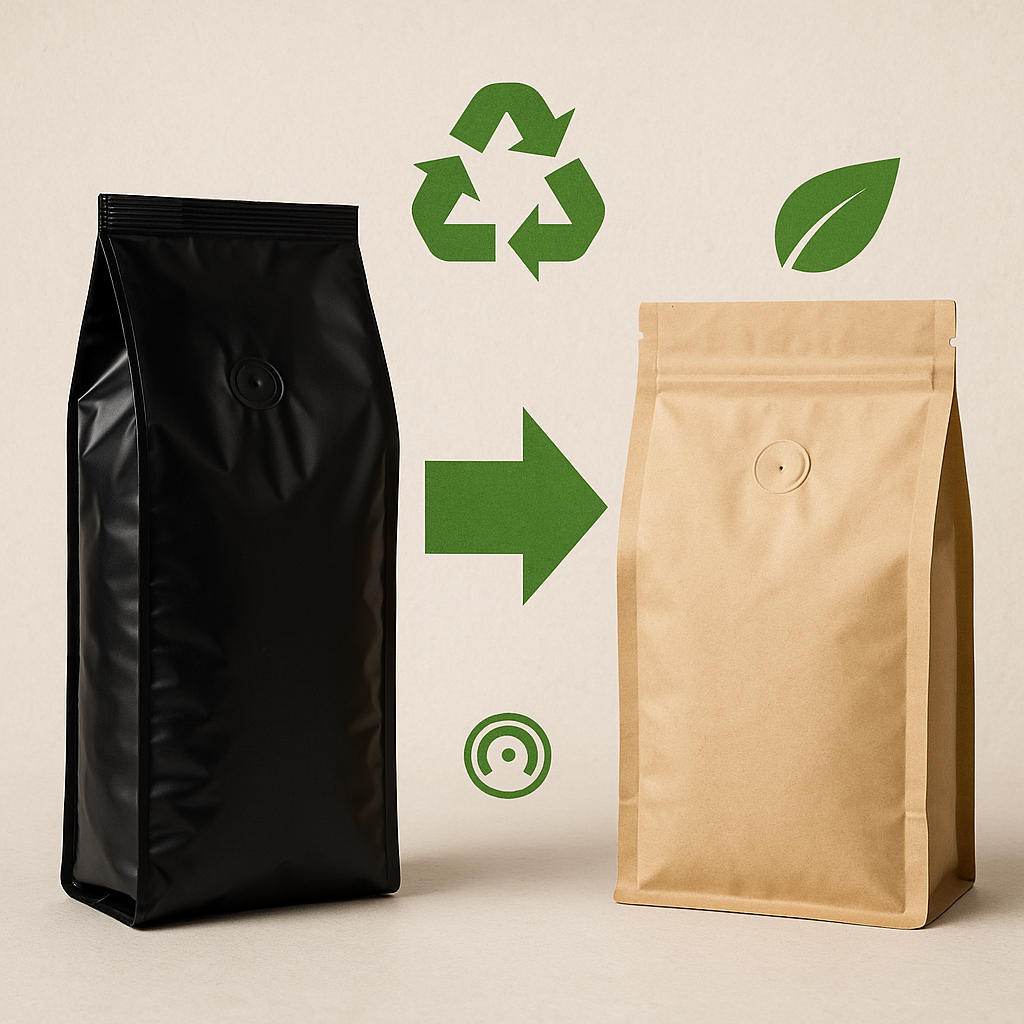The coffee shelf is changing. Once dominated by glossy plastic laminate bags, coffee packaging has now diversified, with paper, mono-plastic, and hybrid packaging competing fiercely for freshness, sustainability, and shelf appeal. For roasters and brands, the shift from plastic bags to paper packaging isn’t just about aesthetics; it’s a strategic response to regulations, retailer demands, and growing consumer awareness.
Why this shift happened
Retailers and consumers alike are pushing for packaging that’s more easily recycled or compostable. The implementation of Extended Producer Responsibility (EPR) programs, stricter waste management regulations in major markets, and a clear consumer preference for “natural” materials are all contributing to the declining popularity of traditional multi-layer plastic laminates. Simultaneously, advances in materials science have led to modern paper-based structures employing thin, plant-based liners or high-performance monolayer films, now offering barrier properties approaching those of traditional plastics while improving disposal options.
Common material choices and their properties
1:Multi-layer plastic laminate (traditional)
Advantages: Excellent barrier properties to oxygen, moisture and light; long shelf life; suitable for export.
Disadvantages: Recycling is difficult due to mixed layers; regulatory friction is increasing in some markets.
2:Recyclable single material film (PE/PP)
Advantages: Designed for existing recycling processes; well-thought-out layering for good barrier properties; low complexity at end-of-life.
Disadvantages: Requires regional recycling infrastructure; may require thicker film to match multi-layer barrier performance.
3:Aluminum foil and vacuum-coated laminates
Advantages: Excellent barrier properties; well-suited for long-distance shipping and highly aromatic single-origin batches.
Disadvantages: Metallized film complicates recycling and reduces compostability.
4:PLA lined kraft and compostable paper bags
Pros: On-trend retail look; certified industrially compostable; strong brand storytelling potential.
Disadvantages: PLA requires industrial composting (not home composting); barrier life is shorter than thick foil unless carefully engineered.
5:Cellulose and biodegradable films
Pros: Transparent, home-compostable options available; strong marketing appeal.
Disadvantages: Typically has a lower barrier to entry; best suited for short supply chains and local sales.
Balancing barrier performance and scrap outcomes
The real challenge lies in technology: oxygen and moisture are the biggest enemies of roasted coffee. Paper alone often lacks sufficient barrier properties to effectively preserve volatile aromatic compounds during long-distance transportation. Consequently, hybrid packaging solutions are becoming increasingly popular—laminated paper outer packaging with a thin, recyclable single-layer film, or using kraft paper bags lined with PLA inner layers. These structures allow brands to present paper packaging to consumers while effectively protecting the contents.
Design and printing considerations
Paper and matte finishes alter the appearance of colors and inks. Tonchant’s production team worked with designers to optimize ink formulations, dot gain, and finishing, ensuring the vellum texture still reproduces crisp logos and clear bake dates. Digital printing allows for small-batch experiments (starting small), allowing brands to test the aesthetics of paper without significant upfront investment.
Supply chain and logistics impact
Material conversions can impact weight, palletizing, and storage. Paper structures may be bulkier or stronger; single-ply films compress more efficiently. Brands should prototype their packaging under realistic warehouse, retail, and shipping conditions to evaluate expansion, seal integrity, and valve performance. Tonchant offers sampling and accelerated shelf-life testing to validate structures before full production.
Sustainability trade-offs to consider
Recyclability vs. compostability: In areas with high plastic collection, recyclable mono-materials may be better, while compostable kraft paper bags are suitable for markets with industrial composting.
Carbon footprint: Thinner, lighter films generally reduce shipping emissions compared to heavier foil laminates.
End-user behavior: Compostable bags lose their advantage if customers are reluctant to compost – local disposal habits are important.
Market trends and retail readiness
Large retailers are increasingly requiring recyclable or paper-based packaging, while specialty markets are rewarding products with visible environmental credentials with premium shelf placement. For exporting brands, strong barrier protection remains crucial – leading many to opt for paper-film hybrids to balance freshness and sustainability goals.
How Tonchant helps brands transform
Tonchant provides comprehensive support to bakers: material selection, print proofing, valve and zipper integration, and low-volume prototyping. Our R&D team assesses barrier requirements based on target distribution channels and recommends viable packaging structures—recyclable mono-material bags, compostable PLA-lined kraft paper, and metallized lamination for extended shelf life. Low minimum order quantities for digital printing allow brands to cost-effectively trial designs and materials, then expand to flexo production as demand grows.
A practical checklist for switching from plastic to paper bags
1:Map your supply chain: local vs. export.
2:Define shelf life targets and test candidate materials under real-world conditions.
3:Match end-of-life claims with local waste disposal infrastructure.
4:Prototypes are produced using the final artwork and sensory checked to ensure aroma retention.
5:Verify valves, zippers and sealing workmanship for selected configurations.
Conclusion: A pragmatic shift, not a panacea
Switching from plastic to paper coffee bags isn’t a one-size-fits-all decision. It’s a strategic trade-off that must consider freshness, handling systems, and brand positioning. With the right partner—one who can provide technical testing, small-batch prototyping, and end-to-end production—brands can make this transition while protecting flavor, meeting regulatory requirements, and resonating with consumers.
If you’re evaluating various material options or need sample packs for side-by-side comparisons, Tonchant can help you plan the optimal path from concept to shelf. Contact us to discuss blended structures, compostable options, and scalable production plans tailored to your baking profile and market.
Post time: Sep-22-2025
